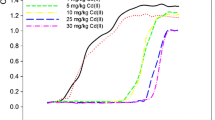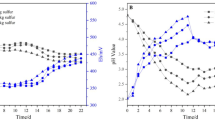Abstract
In the present study, heavy metal (HM)-tolerant phosphate solubilizing bacteria (PSB) were isolated and their performance during the remediation of Pb and Cd in contaminated soil was studied. A total of 16 bacterial strains and one consortium were isolated, and the consortium had the highest phosphate solubilizing ability and HM tolerance. Great variations between the Fourier transform infrared (FTIR) spectra of consortium cells before and after adsorption of Pb2+ and Cd2+ revealed that amide I/amide II bonds and carboxyl on the cell surface were involved in binding of metal ions. High-throughput sequencing technique revealed that the consortium was composed of Enterobacter spp., Bacillus spp., and Lactococcus spp. The consortium was added into contaminated soil, and its potential ability in dissolution of phosphate from Ca3(PO4)2 and subsequent immobilization of HMs was tested. Results showed that when Ca3(PO4)2 was applied at 10.60 mg/g soil, PSB addition significantly increased soil available phosphate content from 12.28 to 17.30 mg/kg, thereby enhancing the immobilization rate of Pb and Cd from 69.95 to 80.76% and from 28.38 to 30.81%, respectively. Microcalorimetric analysis revealed that PSB addition significantly improved soil microbial activity, which was possibly related with the decreased HMs availability and the nutrient effect of the solubilized phosphate. The present study can provide a cost-effective and environmental-friendly strategy to remediate multiple HM-contaminated soils.






Similar content being viewed by others
References
Aafi NE, Saidi N, Maltouf AF, Perezpalacios P, Dary M, Brhada F, Pajuelo E (2014) Prospecting metal-tolerant rhizobia for phytoremediation of mining soils from Morocco using Anthyllis vulneraria L. Environ Sci Pollut Res 22:4500–4512
Bai J, Yang XH, Du RY, Chen YM, Wang SZ, Qiu RL (2014) Biosorption mechanisms involved in immobilization of soil Pb by Bacillus subtilis DBM in a multi-metal-contaminated soil. J Environ Sci 26:2056–2064
Braissant O, Wirz D, Göpfert B, Daniels A (2010) “The heat is on”: rapid microcalorimetric detection of mycobacteria in culture. Tuberculosis 90:57–59
Brenner K, You L, Arnold FH (2008) Engineering microbial consortia: a new frontier in synthetic biology. Trends Biotechnol 26:483–489
Cao XD, Wahbi A, Ma LN, Li B, Yang YL (2009) Immobilization of Zn, Cu, and Pb in contaminated soils using phosphate rock and phosphoric acid. J Hazard Mater 164:555–564
Chen Y, Rekha PD, Arun AB, Shen FT, Lai WA, Young CC (2006) Phosphate solubilizing bacteria from subtropical soil and their tricalcium phosphate solubilizing abilities. Appl Soil Ecol 34:33–41
Chen HL, Yao J, Wang F, Zhou Y, Chen K, Zhuang RS, Zaray G (2010) Investigation of the acute toxic effect of chlorpyrifos on Pseudomonas putida in a sterilized soil environment monitored by microcalorimetry. Arch Environ Contam Toxicol 58:587–593
Costa EMD, De Lima WS, De Oliveiralongatti SM, Souza FM (2015) Phosphate-solubilising bacteria enhance Oryza sativa growth and nutrient accumulation in an oxisol fertilized with rock phosphate. Ecol Eng 83:380–385
de Lacerda JRM, da Silva TFD, Vollu RE, Marques JM, Seldin L (2016) Generally recognized as safe (GRAS) Lactococcus lactis strains associated with Lippia sidoides Cham. are able to solubilize/mineralize phosphate. SpringerPlus 5:828
Fang LB et al (2011) Binding characteristics of copper and cadmium by cyanobacterium Spirulina platensis. J Hazard Mater 190:810–815
Fang YY, Cao XD, Zhao L (2012) Effects of phosphorus amendments and plant growth on the mobility of Pb, Cu, and Zn in a multi-metal-contaminated soil. Environ Sci Pollut Res 19:1659–1667
Ge TD et al (2010) Chemical properties, microbial biomass, and activity differ between soils of organic and conventional horticultural systems under greenhouse and open field management: a case study. J Soils Sediments 11:25–36
Hong C, Si YX, Xing Y, Li Y (2015) Illumina MiSeq sequencing investigation on the contrasting soil bacterial community structures in different iron mining areas. Environ Sci Pollut Res 22:10788–10799
Jiang CY, Sheng XF, Qian M, Wang QY (2008) Isolation and characterization of a heavy metal-resistant Burkholderia sp from heavy metal-contaminated paddy field soil and its potential in promoting plant growth and heavy metal accumulation in metal-polluted soil. Chemosphere 72:157–164
Jones DL, Simfukwe P, Hill PW, Mills RTE, Emmett BA (2014) Evaluation of dissolved organic carbon as a soil quality indicator in national monitoring schemes. PLoS One 9(3):e90882
Li KF, Ramakrishna W (2011) Effect of multiple metal resistant bacteria from contaminated lake sediments on metal accumulation and plant growth. J Hazard Mater 189:531–539
Li ZY, Ma ZW, van der Kuijp TJ, Yuan ZW, Huang L (2014) A review of soil heavy metal pollution from mines in China: pollution and health risk assessment. Sci Total Environ 468–469:843–853
Li JG, Shen MC, Hou JF, Li L, Wu JX, Dong YH (2016) Effect of different levels of nitrogen on rhizosphere bacterial community structure in intensive monoculture of greenhouse lettuce. Sci Rep 6:25305
Liang Y, Cao XD, Zhao L, Arellano E (2014) Biochar- and phosphate-induced immobilization of heavy metals in contaminated soil and water: implication on simultaneous remediation of contaminated soil and groundwater. Environ Sci Pollut Res 21:4665–4674
Margesin R, Plaza GA, Kasenbacher S (2011) Characterization of bacterial communities at heavy-metal-contaminated sites. Chemosphere 82:1583–1588
Mishra BK, Meena KK, Dubey PN, Aishwath OP, Kant K, Sorty AM, Bitla UM (2016) Influence on yield and quality of fennel (Foeniculum vulgare Mill.) grown under semi-arid saline soil, due to application of native phosphate solubilizing rhizobacterial isolates. Ecol Eng 97:327–333
Naik MM, Dubey SK (2013) Lead resistant bacteria: lead resistance mechanisms, their applications in lead bioremediation and biomonitoring. Ecotox Environ Safe 98:1–7
Nautiyal CS (1999) An efficient microbiological growth medium for screening phosphate solubilizing microorganisms. FEMS Microbiol Lett 170:265–270
Nisa M, Coral U, Korkmaz H, Arikan B, Coral G (2005) Plasmid mediated heavy metal resistances in Enterobacter spp. isolated from Sofulu landfill, in Adana, Turkey. Ann Microbiol 55:175–179
Niu FJ et al (2014) Effects of enhanced UV-B radiation on the diversity and activity of soil microorganism of alpine meadow ecosystem in Qinghai–Tibet Plateau. Ecotoxicology 23:1833–1841
Pan LB, Ma J, Wang XL, Hou H (2016) Heavy metals in soils from a typical county in Shanxi Province, China: levels, sources and spatial distribution. Chemosphere 148:248–254
Park JH, Chon HT (2016) Characterization of cadmium biosorption by Exiguobacterium sp. isolated from farmland soil near Cu-Pb-Zn mine. Environ Sci Pollut Res 23:11814–11822
Park JH, Bolan N, Megharaj M, Naidu R (2011a) Concomitant rock phosphate dissolution and lead immobilization by phosphate solubilizing bacteria (Enterobacter sp.) J Environ Manag 92:1115–1120
Park JH, Bolan N, Megharaj M, Naidu R (2011b) Isolation of phosphate solubilizing bacteria and their potential for lead immobilization in soil. J Hazard Mater 185:829–836
Porter SK, Scheckel KG, Impellitteri CA, Ryan JA (2004) Toxic metals in the environment: thermodynamic considerations for possible immobilization strategies for Pb, Cd, As, and Hg. Crit Rev Environ Sci Technol 34:495–604
Rodriguez H, Fraga R (1999) Phosphate solubilizing bacteria and their role in plant growth promotion. Biotechnol Adv 17:319–339
Scheckel KG et al (2013) Amending soils with phosphate as means to mitigate soil lead hazard: a critical review of the state of the science. J Toxicol Env Heal B 16:337–380
Vecchio A, Finoli C, Disimine D, Andreoni V (1998) Heavy metal biosorption by bacterial cells. Fresenius J Anal Chem 361:338–342
Wang F, Yao J, Chen HL, Chen K, Trebše P, Zaray G (2010) Comparative toxicity of chlorpyrifos and its oxon derivatives to soil microbial activity by combined methods. Chemosphere 78:319–326
Wang T et al (2014) The immobilization of heavy metals in soil by bioaugmentation of a UV-mutant Bacillus subtilis 38 assisted by NovoGro biostimulation and changes of soil microbial community. J Hazard Mater 278:483–490
Yuan ZM et al (2016a) Potentially toxic trace element contamination, sources, and pollution assessment in farmlands, Bijie City, southwestern China. Environ Monit Assess 189:25
Yuan ZM, Zhao Y, Guo ZW, Yao J (2016b) Chemical and ecotoxicological assessment of multiple heavy metal-contaminated soil treated by phosphate addition. Water Air Soil Pollut 227:403
Yuan ZM, Liu HJ, Han J, Sun JJ, Wu XY, Yao J (2017) Monitoring soil microbial activities in different cropping systems through combined methods. Pedosphere 27(1):138-146
Zhang W, Chen L, Zhang R, Lin KF (2016) High throughput sequencing analysis of the joint effects of BDE209-Pb on soil bacterial community structure. J Hazard Mater 301:1–7
Zhou W, Liu D, Ho Z, Kong W, Zhang Y (2014) Bioremoval and recovery of Cd(II) by Pseudoalteromonas sp. SCSE709-6: comparative study on growing and grown cells. Bioresour Technol 165:145–151
Acknowledgements
This work is supported in part by grants from public welfare project of Chinese Ministry of Environmental Protection (201409042, 201509049), key project from National Science Foundation of China (41430106), National Natural Science Foundation of China (41273092, U1402234), and Fundamental Research Funds for the Central Universities (FRF-OT-16-022).
Author information
Authors and Affiliations
Corresponding authors
Additional information
Responsible editor: Zhihong Xu
Rights and permissions
About this article
Cite this article
Yuan, Z., Yi, H., Wang, T. et al. Application of phosphate solubilizing bacteria in immobilization of Pb and Cd in soil. Environ Sci Pollut Res 24, 21877–21884 (2017). https://doi.org/10.1007/s11356-017-9832-5
Received:
Accepted:
Published:
Issue Date:
DOI: https://doi.org/10.1007/s11356-017-9832-5




